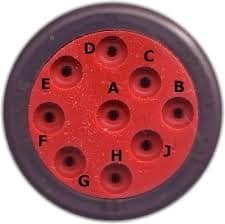The SAE J1939 protocol is vital for communication and diagnostics in heavy-duty vehicles and off-road equipment. A key element of this protocol is the Diagnostic Trouble Code (Dtc J1939), a critical piece of information used for troubleshooting and maintenance. This article provides a detailed overview of DTC J1939, covering its structure, related diagnostic messages, and how it helps in identifying and resolving vehicle issues.
Decoding the DTC J1939 Structure
A DTC J1939 is a 32-bit code that pinpoints specific malfunctions within a vehicle’s systems. It comprises four distinct fields:
- Suspect Parameter Number (SPN): A 19-bit identifier representing the specific component or system experiencing the issue. This utilizes existing Parameter Group Numbers (PGNs) defined within the J1939 standard, streamlining the diagnostic process.
- Failure Mode Identifier (FMI): A 5-bit code classifying the nature of the fault. FMIs categorize issues ranging from voltage irregularities and sensor malfunctions to system communication errors. Understanding the FMI provides crucial context for effective troubleshooting.
- Occurrence Count (OC): A 7-bit counter tracking the number of times the specific fault has occurred. This helps technicians understand the frequency and persistence of the problem.
- SPN Conversion Method (CM): A single bit indicating the byte alignment method used within the DTC. While older methods exist, the current standard utilizes Method 4, ensuring consistency in data interpretation.
 SAE J1939 diagnostics 9 pin connector
SAE J1939 diagnostics 9 pin connector
Caption: The 9-pin J1939 diagnostic connector provides access to critical vehicle data for troubleshooting.
Key Diagnostic Messages Associated with DTC J1939
Several J1939 diagnostic messages (DMs) facilitate the transmission and management of DTCs:
- DM1 (PGN 65226): Active Diagnostic Trouble Codes: This message periodically broadcasts all currently active DTCs and warning lamp statuses (e.g., Malfunction Indicator Lamp – MIL). It allows for real-time monitoring of vehicle health.
- DM2 (PGN 65227): Previously Active Diagnostic Trouble Codes: This message, sent upon request, lists DTCs that were previously active but are not currently present. The OC provides valuable historical data for diagnosing intermittent issues.
- DM3 (PGN 65228): Clear Previously Active DTCs: This message clears all historical DTC data, including logged faults and freeze frame information.
- DM4 (PGN 65229): Freeze Frame Data: Triggered by a fault, this message captures a snapshot of vehicle operating parameters at the time of the malfunction, providing crucial context for diagnosis.
- DM11 (PGN 65235): Clear Active DTCs: This message clears all currently active DTCs.
- DM12 (PGN 65236): Emission-Related Active DTCs: This message specifically reports active DTCs related to emissions systems, vital for compliance and environmental regulations.
Utilizing DTC J1939 for Effective Troubleshooting
DTC J1939 information, combined with the associated diagnostic messages, provides a powerful framework for identifying and resolving vehicle issues:
- Fault Isolation: The SPN within the DTC directly points to the affected component or system, narrowing down the search area for technicians.
- Fault Type Identification: The FMI clarifies the nature of the malfunction, indicating whether it’s a sensor issue, a circuit problem, or another type of failure.
- Fault History Analysis: The OC reveals how often a fault has occurred, helping differentiate between intermittent glitches and persistent problems.
- Targeted Repairs: By understanding the specific fault indicated by the DTC J1939, technicians can perform targeted repairs, minimizing downtime and maximizing efficiency.
Conclusion
DTC J1939 is a cornerstone of the J1939 protocol, enabling efficient diagnostics and maintenance in heavy-duty vehicles. By understanding its structure and related diagnostic messages, technicians can effectively interpret fault codes, pinpoint the root cause of issues, and perform targeted repairs. This comprehensive approach to diagnostics ultimately leads to improved vehicle uptime, reduced maintenance costs, and enhanced operational efficiency.
